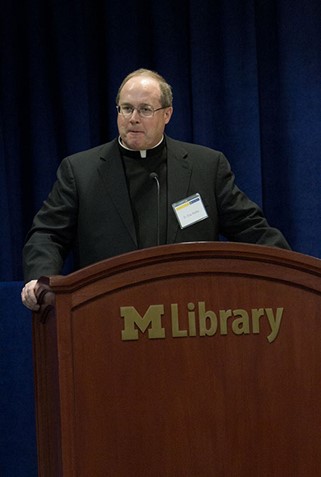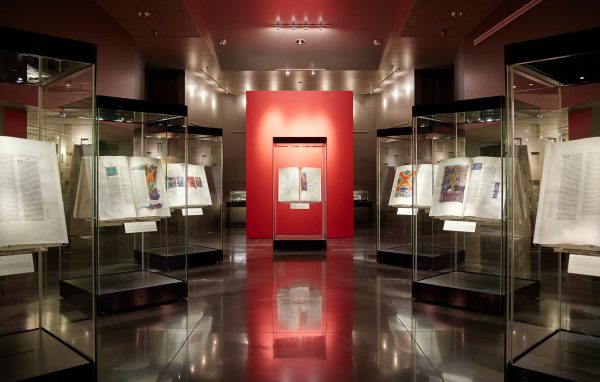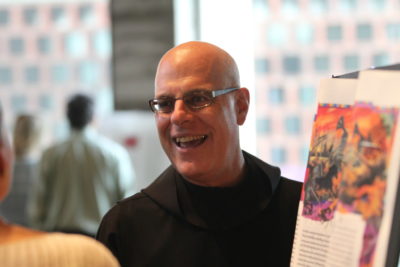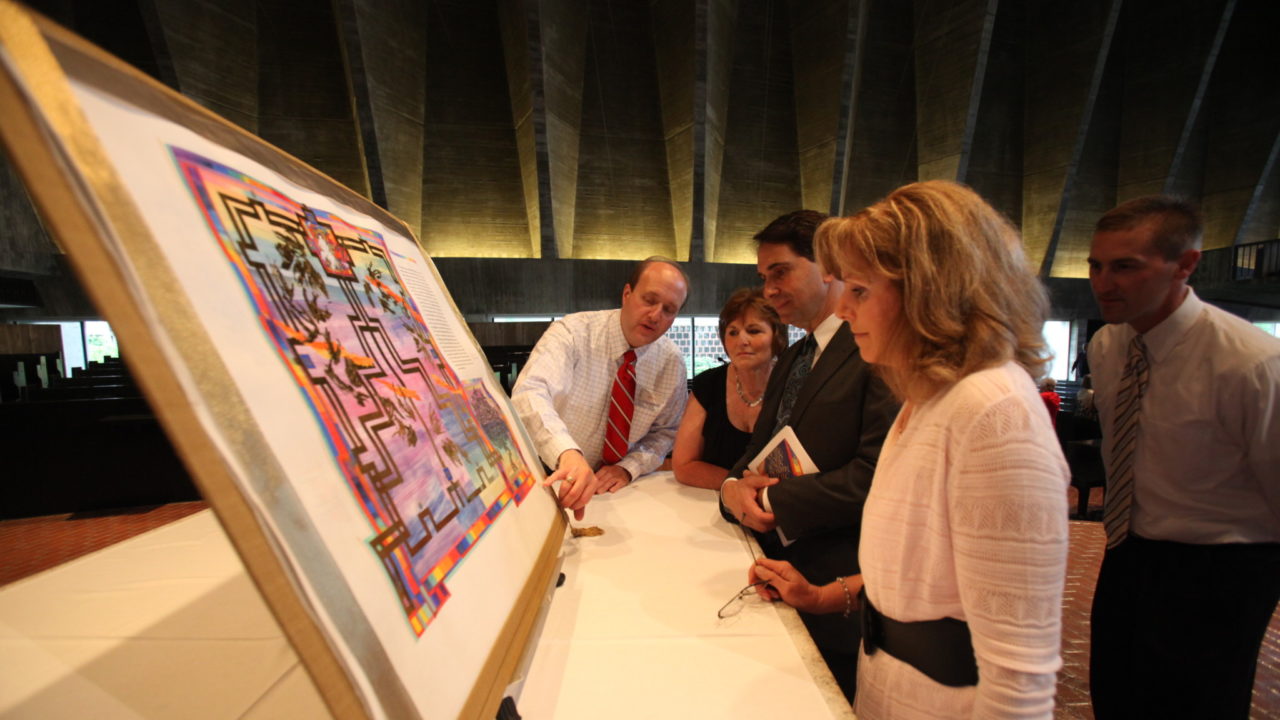Father Eric Hollas, OSB, recalls his first conversation with Donald Jackson about what would become The Saint John’s Bible. The year was 1995, and the two had just given a joint presentation on calligraphy at the Newberry Library in Chicago. Over lunch, Jackson raised “his life’s ambition, which was to make a handwritten, illuminated, monumental Bible,” says Fr. Hollas.
Jackson asked Fr. Hollas if Saint John’s Abbey and University might be interested in the project, and as Fr. Hollas recalls, “I thought, ‘That’s a great idea. And of course we would not be interested in this because this is not the kind of thing monasteries or universities do today.’ But I distinctly remember saying to him, ‘Yes, I think we might be interested.’ So at the time I thought I was lying, but it turned out I was actually telling the truth.”
To say, “the rest is history” is to dramatically condense the years of painstaking work that came afterward for the teams that planned and created The Saint John’s Bible, who just last month celebrated the ten-year anniversary of the completion of their project. In their reflections on the anniversary, Fr. Hollas, Father Michael Patella, chair of the Committee on Illumination and Text, and Tim Ternes, Director of The Saint John’s Bible, have also shared thoughts on all that has happened since that day in 2011, and their hopes for the Bible far into the future.
Tangible Around the World

As Donald Jackson reminded the audience at the event honoring the Bible’s completion, its legacy is not that it exists, but rather what its caretakers choose to do with it. From the inception of the project, Fr. Hollas says that the team thought carefully about how they could share this one-of-a-kind project with the biggest audience possible, knowing that most people wouldn’t be able to make the trip to Collegeville to see the original.
“We were all very conscious of the fact that we were designing this for an electronic world,” he says. “We knew that we would take advantage of the internet in ways that previous manuscripts could never do. We also knew that we wanted a limited, fine art edition—what became the Heritage Edition. We’d have real, tangible images of the Bible in front of people all over the world.”
The 299 Heritage Editions of The Saint John’s Bible are now fulfilling that goal in locations as far abroad as Hong Kong and Australia. In addition to the sites that have permanently acquired a Heritage Edition, many others have hosted A Year with The Saint John’s Bible, during which they have created programming and events with the Gospels & Acts volume and hosted lecturers from Saint John’s, including Fr. Hollas, Fr. Patella, and Ternes. (If your organization is interested in learning more about A Year withThe Saint John’s Bible or acquiring one of the remaining sets, contact us.)
Never the Same Exhibition
The original pages of The Saint John’s Bible do their share of world travel as well. Even before the Bible was fully completed, 98 bifolia were used in a national touring exhibition, “Illuminating the Word: The Saint John’s Bible,” which began in 2005 and still continues today. Bifolia have also been exhibited as part of larger exhibitions alongside the Dead Sea Scrolls and other ancient texts.
“What’s exciting is that it is basically the same pages at every museum, but it is never the same exhibition,” says Ternes. “I’ve been involved with close to 30 exhibitions, and I have had unique and unusual and different conversations at every single one. It’s trite to say that you learn something new every time but I really do. I’ve seen transformative things. I’ve seen bikers in leather talking to little old ladies about what’s on the pages; I’ve seen high school kids drag their parents in, saying, ‘You’ve got to see this.’”

© Wayne Torborg, 2018, Hill Museum & Manuscript Library, Saint John’s University, Collegeville, Minnesota, USA. Used with permission.
Of course, the true home of The Saint John’s Bible is in Collegeville, and in 2017 the University opened its permanent gallery for the Bible. The exhibition takes advantage of the fact that the folios are as yet unbound, as they will likely remain for the next 15 to 20 years. Minimalist display cases place all the visual emphasis on the folios and invite contemplation and community.
“The goal was not to create a shrine to the Bible,” says Ternes. “The Saint John’s Bible is meant to be an invitation for people to come together and talk about it, so that communal conversation is key. When I designed the gallery, I wanted to create a space in which the structure disappeared. Then when you walked in, all you really saw was the Bible.
“What’s happened is it’s created a space where people come in and gather and talk about what they see and how they engage with it,” he says. “And part of the programming that we do is to not tell the stories. People say, ‘Tell me about this artwork,’ and I could do that, but then the story ends. I say, ‘Let’s unpack it together because it’s going to be a different story for you, and if you grab that person over there, it’s going to create a new story.’ The gallery serves as a physical invitation into conversation.”
“We all bring part of ourselves”

Fr. Patella echoes Ternes’ observations about the individual nature of responses to the art. He says about the process, “You show the image, and because we all bring part of ourselves to each experience, it resonates differently within each person. I enjoy hearing people’s reactions and insights. The process involves both teaching and learning, and it is always exciting.”
In Fr. Hollas’s talks, he encourages listeners to translate their experience with the art of the Bible into their other interactions with art and their surroundings. “I talk to people about the power of human creativity to translate the sacred into visual form,” he says. “At the end, I tell them, ‘Now you can take what I’ve just told you and apply this to any kind of art that you experience in your life.’
“Someone designed your house,” he continues, “no matter whether it’s plain or brutal or beautiful—read your house and how that impacts you and shapes your life. Read the architecture of your church. Someone designed it, even if it’s plain, with nothing by way of decoration—that’s a statement of religious values, as is the church filled with Baroque architecture and design. Read the visuals in your life because they’re communicating something to you.
“Opening up to that kind of vision has been a surprise to people because it also allows them to take ownership and responsibility for their ability to see,” he says. “It’s like when Jesus says, ‘If you have eyes to see, see; ears to hear, hear.’”
“We managed to outdo ourselves.”
Fr. Patella is hopeful that the Bible and its outreach around the world will continue to inspire 21st century viewers. “I hope that people are drawn to the faith because of it,” he says. “Beauty is a way of proclaiming the gospel too. You can use words, you can use beauty, and I would like to see the beauty of The Saint John’s Bible be a way of inspiration to bring people back or even call people forward to the faith and to the church. I hope that’s what it does.”
As Fr. Hollas reflects on his expectations at the beginning of the project compared to today’s reality, he recalls, “Donald said, ‘I will give you exactly what you asked for, but more than you ever imagined.’ And I thought I knew what we were asking for, but I never quite envisioned the huge potential that was realized. In retrospect, I can scarcely believe that we had the chutzpah to set goals that were more than modest. I worried if we could even make the goals that we had set. Well, we managed to outdo ourselves on virtually everything.”

